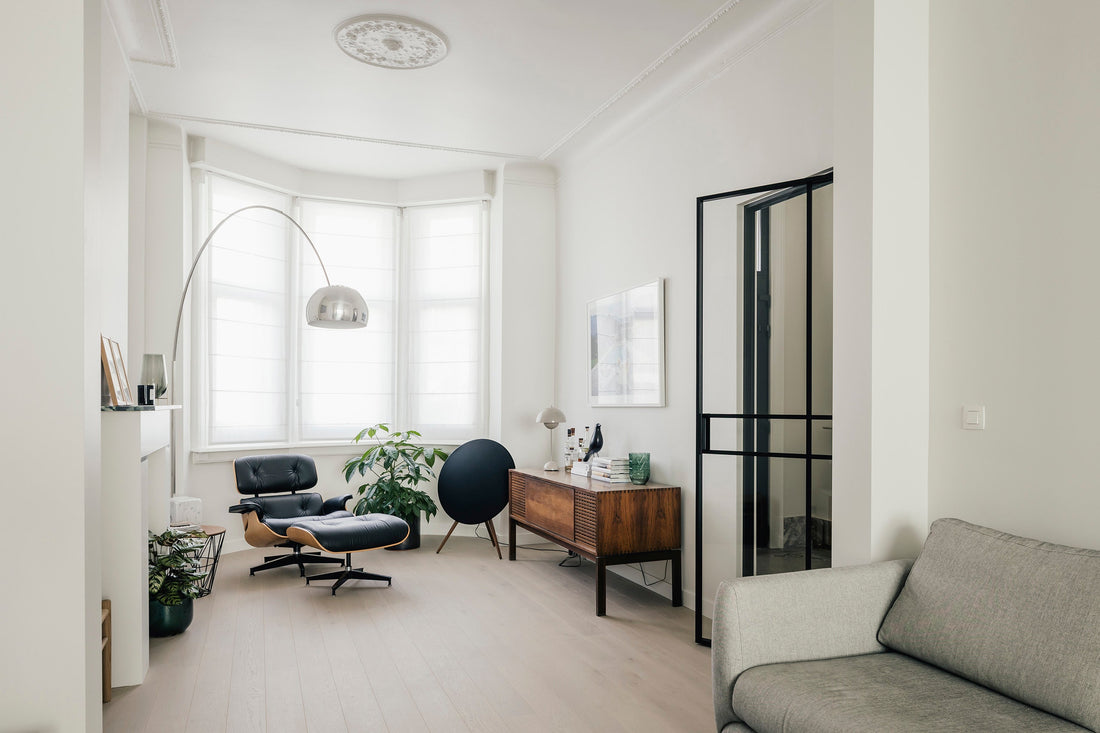
Do Steel Doors Rust Inside?
Samuel MorrisDo Steel Doors Rust Inside? Everything You Need to Know Before Buying Steel Doors
Steel doors have become a popular choice in both residential and commercial architecture due to their strength, security, and contemporary style. Whether you’re renovating a modern home, designing a high-end office, or specifying materials for a new development, steel doors tick many boxes: sleek looks, custom options, long lifespans, and robust performance. But one question persists—do steel doors rust inside?
View OTIF Steel Door Collections - Click Here

It’s a valid concern, especially for buyers investing in premium bespoke steel doors or specifying them in areas with high humidity or moisture exposure. In this post, we’ll break down the science, design, and maintenance realities behind rust in steel doors—particularly what’s happening inside the door. We’ll also explain how to prevent rust from the inside out and what separates high-quality steel doors from the rest.
Understanding Steel Doors: A Quick Primer
Before diving into rust, it helps to understand what steel doors are made of and how they’re constructed.
Most internal or external steel doors are made from galvanised steel sheets formed around an internal core. That core might be:
- Honeycomb cardboard (for lightweight, budget interior doors)
- Polyurethane foam (for thermal insulation)
- Steel reinforcements (for security and durability)
- Mineral core or solid steel (in fire-rated doors)
They’re then sealed, primed, and often powder-coated or painted for appearance and corrosion resistance. High-end steel doors, especially internal glazed doors, feature slimline frames, high-tolerance welding, and sealed units—all of which contribute to how well they resist moisture ingress.

What Is Rust, and How Does It Form?
Rust is the common term for iron oxide, a compound that forms when iron or steel is exposed to oxygen and moisture over time. It weakens the metal structure and leads to flaking, discolouration, and eventually structural failure if left unchecked.
Rust forms in three stages:
- Initial oxidation – exposure to oxygen.
- Moisture intrusion – contact with water or high humidity accelerates the process.
- Corrosive expansion – rust expands and eats into the steel from the inside out.
Inside a steel door, this process is only likely to occur if moisture finds its way in and the steel isn’t properly protected.

Can Steel Doors Rust on the Inside?
In Short: Yes—But Only Under Certain Conditions.
Steel doors are usually designed to resist internal rust, but like any product, their resilience depends on build quality, installation, and environmental exposure. Let’s break it down.
1. Door Type Matters
-
Exterior Steel Doors: These are most at risk because they’re exposed to rain, condensation, and temperature shifts. Poorly sealed seams or screw holes can let in water, leading to internal rust.
-
Interior Steel Doors: These are much less likely to rust, especially in dry environments like homes or offices. However, bathrooms, kitchens, or pool areas can pose a risk if moisture builds up.
-
Fire-Rated Steel Doors: These often have mineral or steel cores and heavier construction. If moisture seeps into the fireproof core, rust can occur over time—particularly in poorly made models.
2. Material Quality Plays a Critical Role
- Galvanised Steel: Coated with zinc to prevent rust. This is standard in quality doors.
- Stainless Steel: Contains chromium and other metals that resist corrosion even better—but is far more expensive.
- Mild Steel: Prone to rust without proper coatings.
Cheaper doors may not be galvanised, or may have inconsistent coatings, leaving them vulnerable.
3. Design & Sealing
How the door is built makes all the difference. Look for:
- Welded seams and corners that are ground smooth and sealed.
- Drainage holes and weep systems in exterior doors to allow moisture to escape.
- Fully enclosed profiles in interior steel doors, especially in glazed designs.
High-end manufacturers like OTIF Steel use high-tolerance fabrication and seamless, powder-coated finishes to ensure moisture can’t penetrate the internal frame.
4. Installation Errors Can Invite Rust
Even the best door can rust if it’s poorly installed. Common mistakes include:
- Leaving cut edges or screw holes exposed without re-sealing.
- Installing in direct contact with wet surfaces (e.g., concrete) without isolation.
- Using non-galvanised fasteners or hinges that rust and bleed into the steel.
A good installer knows to seal all edges, paint over fixings, and maintain weather-tight thresholds—especially on exterior doors.

Common Signs of Internal Rust in Steel Doors
Internal rust doesn’t always show itself until significant damage is done. Look out for:
- Bulging or bubbling paint on the door surface.
- Rust streaks or drips from joints or seams.
- Unusual creaking, cracking, or weakening of the door structure.
- Flaking edges or corners, especially near glass inserts or hinges.
If you catch it early, you may be able to stop the spread. Left untreated, internal rust can compromise security, fire integrity, and visual appeal.

Where Internal Rust Is Most Likely to Happen
- Bottom edge of exterior doors where water can pool.
- Screw holes for hardware, especially handles or glazing beads.
- Around unsealed glass inserts, where condensation forms.
- Within hollow frames if condensation or moisture enters and cannot evaporate.

Best Practices to Prevent Internal Rust
1. Choose High-Quality, Galvanised or Stainless Steel
Opt for doors from reputable manufacturers that use:
- Thick galvanised steel (at least 18 gauge) for durability.
- Fully welded and sealed joints.
- Powder coating or baked-on primers for extra protection.
Brands like OTIF Steel and RK Steel Doors use top-tier materials and fabrication methods designed to resist internal rust for decades.

2. Check for Proper Sealing
- Seams, mitres, and joints should be fully sealed with no visible gaps.
- Any penetrations (e.g., for glazing) must be lined or sealed with gaskets.
- Look for doors that come pre-treated and finished, not raw steel.

3. Paint and Maintain Regularly
Even powder-coated steel can wear over time. Protect your door with:
- Repainting if chips or scratches appear.
- Rust-inhibiting primers if you're touching up yourself.
- Lubricating hinges and moving parts to prevent condensation.

4. Install with Moisture Control in Mind
- Use moisture barriers if installing near concrete or stone.
- Avoid installing doors directly into damp substrates.
- Make sure there's adequate ventilation, especially in bathrooms or utility rooms.

5. Ask Your Supplier the Right Questions
Before purchasing, ask:
- Is the steel galvanised or stainless?
- How is the door sealed from moisture?
- Are glazing and hardware areas protected against rust?
- What warranty does the door have against internal rust?

What If My Steel Door Is Already Rusting?
If you spot signs of internal rust, act quickly:
- Remove paint or coatings around the affected area.
- Clean rust with a wire brush or rust remover.
- Treat with a rust converter or primer that stops corrosion.
- Seal and repaint with weather-resistant steel paint.
For severe rust, especially in structural areas, it may be safer (and more cost-effective) to replace the door entirely.

Steel Door Alternatives: Are There Rust-Free Options?
If you’re concerned about rust but want the look of steel, you have options:
- Aluminium Doors: Lighter, won’t rust—but can dent more easily.
- Timber-Look Steel Doors: Offer steel strength with timber aesthetics.
- Powder-Coated Composite Doors: Durable and moisture-resistant, but lack the sleek minimalism of true steel.
Ultimately, well-made steel doors remain the best for strength, fire safety, and security, especially in architectural applications. Just ensure you’re buying from a reputable, high-spec supplier.
Final Verdict: Do Steel Doors Rust Inside?
Yes—but only if they’re poorly made, installed, or maintained.
Modern, high-quality steel doors are designed to resist internal rust for decades, especially when constructed with galvanised steel, precision welding, and protective coatings.
If you're buying for a renovation project, specifying bespoke doors, or installing in a sensitive area (like bathrooms or coastal homes), invest in well-made doors from trusted manufacturers. That means:
- Proper coatings and galvanisation.
- Attention to joints and seams.
- Good installation practice.
- Occasional maintenance.

The result? A stunning, long-lasting steel door that won’t rust from the inside out—and continues to elevate your space for years to come.
Interested in high-quality steel doors that won’t rust?
At Interior Doors Ltd, we supply bespoke OTIF steel doors designed for luxury homes and commercial spaces. Visit our Berkshire showroom or explore our range of custom internal steel doors, pivot doors, sliding doors, and fire-rated options online today.
